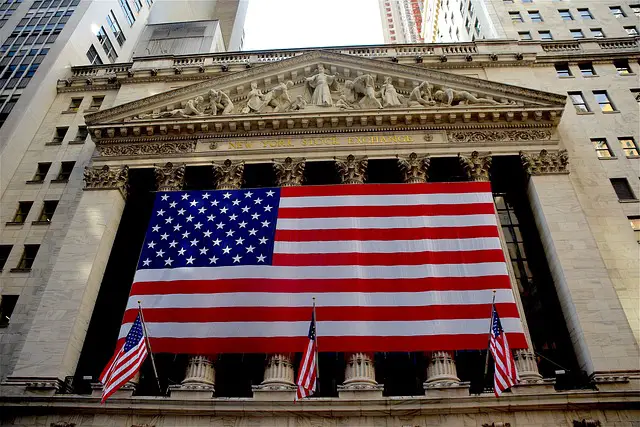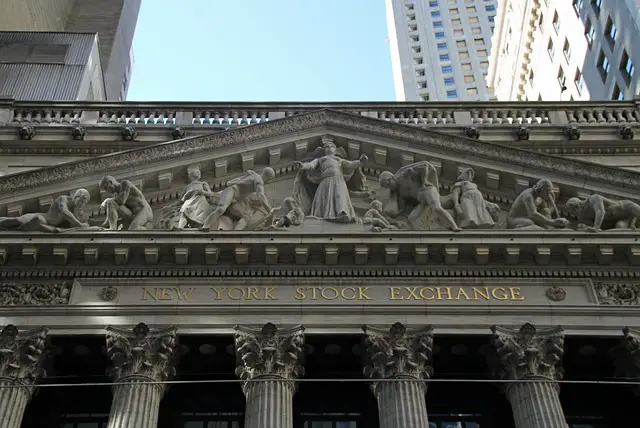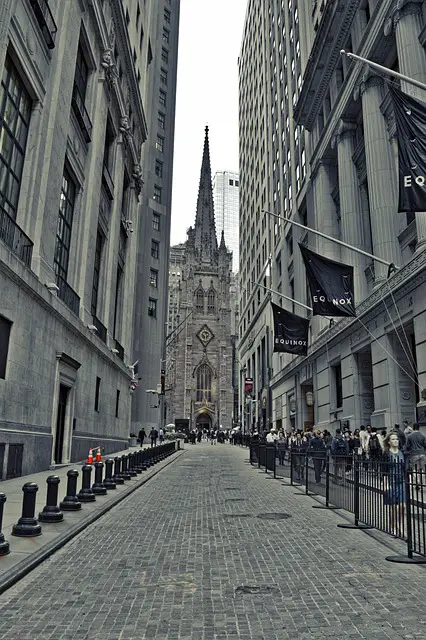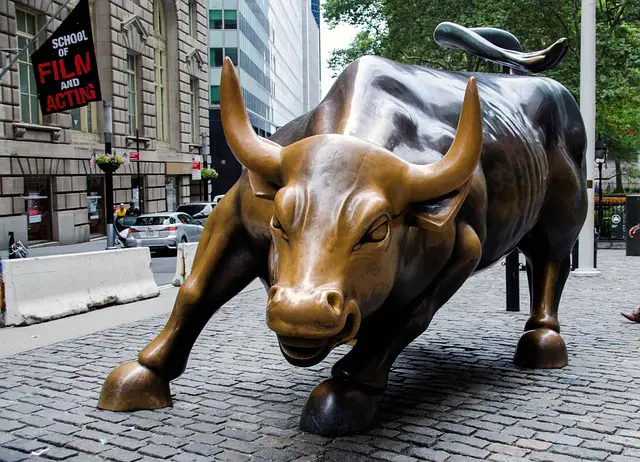Wall Street
Introduction
Wall Street is a street in Lower Manhattan, New York City. The street has historically been the hub of financial companies such as banks and the New York Stock Exchange.
It has also been the headquarters of many financial giants of the United States. As a result, the street has become synonymous with being the financial hub of the country and is often used interchangeably with the financial services industry of America.
History before American Revolution
Before the American Revolution, the site of the present-day Wall Street was the official slave market of New York City. This was where slaves were bought and sold. The slave market remained functional at the site from 1711 to 1762.

The city imposed taxes on all the slaves which were bought and sold. Towards the latter half of the 18th century, traders and speculators started gathering under a buttonwood tree to trade securities. This became the precursor to the Buttonwood Agreement which in turn would lead to the early foundations of the Wall Street.
Buttonwood Agreement
Buttonwood Agreement was an attempt to organize and structure the trading of securities of Wall Street. A group of stockbrokers came together to clearly define commission rates and other regulations, such as not dealing with the auctioneers.
The Buttonwood Agreement became the precursor to the New York Stock Exchange. NYSE would ultimately contribute a great deal in making Wall Street the financial hub of the country.
During the 19th century
Wall Street saw a major boom during the 19th century. This was a time when the financial foundations of the country were growing mature. The economy grew and its basis changed from agricultural to industrial.
New York saw many significant developments, such as the opening of the Erie Canal. This further boosted the economic outlook of the city.
More and more businesses started establishing their offices along Wall Street. Residents, annoyed at the clamor of the business enterprises, shifted away from the area which eventually made it a street lined with businesses.
The Civil War and the Banking Boom
In the second half of the 19th century, United States was embroiled in a long and bloody Civil War. The war caused a major boom to the northern economy which in turn boosted the growth of the financial capital of the North, and Wall Street.
Around the same period, banks grew rapidly in size, giant trusts were established and stock trading became a booming activity. All of these significantly contributed towards the growth of the Wall Street.
Wall Street in the 20th century
During the early 20th century, Wall Street reached the peak of its importance in the American economy. Around this time, the site saw the rise of many skyscrapers. A notable event in the 20th century history of the Wall Street was the stock market crash of 1929. The crash, caused primarily by the lack of adequate regulation of the financial activity at Wall Street, ushered in the Great Depression era.
This was one of the worst financial downturns of the country and Wall Street lost much of its importance as a result. Towards the later 20th century, governments began attempts to better regulate Wall Street financial activities. This was intermittently interrupted by other attempts towards more liberal economic policies.
Architecture
Wall Street is noted for the extraordinary architecture featured by many of its buildings. Most of the buildings have a Gilded Age style architecture which combines elements of the ancient Greek and Roman styles with 19th century elements.
Many buildings have elaborate facades which, together with the narrow streets that around them, provide for breathtaking, looming views of the structures. Notable structures dotting Wall Street include the Federal Hall National Monument and the New York Stock Exchange.
Famous Buildings on the Wall Street
Wall Street is home to a number of famous buildings which are well-recognized in American culture for their cultural, historic or architectural significance. The most historically important structure on Wall Street is the Federal Hall.

The Hall has a neoclassical architecture and has been the site of George Washington’s inauguration as the 1st President of the United States. The Deutsche Bank Building sits on the former site of the J.P. Morgan headquarters, once deemed the heart of the Wall Street.
The New York Stock Exchange, built in the style of a neoclassical temple, is another landmark of the area. Other significant structures at the Wall Street include The Trump Building and the 55 Wall Street, formerly home to the Citicorp.
Economic and Financial Importance
Being the historic financial hub of New York City and the United States at large, Wall Street has remained of immense economic and financial significance. At its heyday, fluctuations and changes at Wall Street directly shaped the American economic outlook.
The stock market crash of 1929 is an example – the downturn in Wall Street financial activity led to one of the worst economic depressions in the country’s history.
Although many major financial entities have moved out of Wall Street today, it is still the home of New York Stock Exchange – the largest stock exchange in the world. For this reason, Wall Street still remains immensely significant and relevant for the American economy.
The Culture of Wall Street
Wall Street is noted for a unique culture which is embodied by most of the people working there. Greed and self-interest are often deemed the cornerstones of this culture. Wall Street employees are often depicted with these qualities in American movies and pop culture.

Many researches indicate that these depictions are accurate to a great degree. In fact, amassing wealth and using whatever means available to do so is considered an admirable trait among Wall Street employees. It also reflects somewhat on a society which accords respect based on the amount of money a person makes.
The Decline of the Wall Street
The 21st century marks the decline of the Wall Street in many ways. Online stock trading has surpassed the importance of the New York Stock Exchange. Banking interests have shifted elsewhere.
Other centers around the world have grown as financial markets and capital is more accumulated in places such as Shanghai than it once did at the Wall Street. In many ways, the Street is now a landmark of the past, a relic of the golden age of American economics.
- Famous American Buildings
- Capitol Building
- Central Park New York
- Chrysler Building
- Empire State Building
- Flatiron Building
- Golden Gate Bridge
- Grand Central Terminal
- Jefferson Memorial
- Lincoln Memorial
- Memorial Statues
- One World Trade Center
- Statue of Liberty
- Top 10 American Buildings
- Top 10 American Memorials
- Top 10 American Skyscrapers – Awe Inspiring
- Wall Street
- Washington Monument
- Washington National Cathedral
- White House
- Willis Tower




